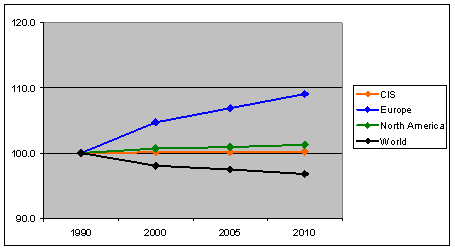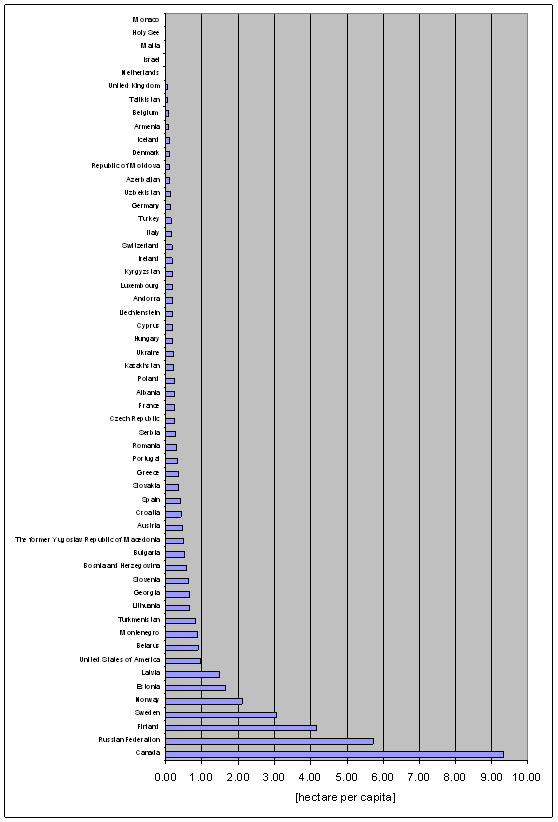In 2010, the total forest area in Europe, North America, the Caucasus and Central Asia (the UNECE region) was over 1.6 billion hectares - half of which is in the Russian Federation, and 37% of which is in the United States and Canada. Altogether, the UNECE region includes 40% of the world’s forests, most of these forests being classified as boreal or temperate.
Since the 1990s, the forest area in Europe, North America, Caucasus and Central Asia has been increasing steadily. Forest area in the region has grown by 25 million hectares over the last 20 years (a size equivalent to the surface of the United Kingdom), or an average of 1.25 million ha per year (equivalent to an area slightly smaller than Montenegro). In the pan-European region* alone, the forest area increased by 17 million hectares in the last two decades. In addition to forest area, the volume of wood in pan-European forests is growing - by over 430 million cubic meters every year (which corresponds to a 1 cubic meter ring around the globe) due to the expansion of the forest area and increases in stock levels. In North America, the area of forests increased by almost 8 million hectares in the same period, mainly due to afforestation in the USA.
Forests play an important role in the conservation of biological diversity and the area of forest primarily designated for this purpose is also expanding. In the UNECE region it increased by almost 25 million ha during the period 1990-2010, and currently accounts for about 8% of the total forest area in the region. Most of this increase took place in Europe, the Caucasus and Central Asia, where the area of forest specifically managed for conservation of biological diversity has been increasing by almost one million ha annually over the past 20 years, while in North America it increased by more than 5 million ha since 1990.
While, globally, carbon stocks are decreasing as a result of the loss of forest area, thus causing substantial carbon emissions, UNECE’s forests, which store almost 80 billion tons of carbon in their biomass, are continuing to increase the amounts of atmospheric carbon that they sequester. The stock of sequestered carbon has increased by almost 5 billion tons during the last twenty years. In the smaller, pan-European region the net sequestration of carbon in forest biomass reached around 3 billion tons between 1990 and 2010. This means that forests absorb around 7 percent of the annual GHG emissions from the region.
In addition to increasing biomass and carbon stocks, forests also provide raw material for industrial and energy purposes. UNECE forests generated about 20 billion cubic meters of woody raw material in the 1990-2010 period.
However, catastrophic events, primarily the result of increasing climate variability, have impacted negatively on forest growth and health. North America reported the largest area of forests with insect-related health problems for 2005 compared to any other region (some 23 million hectares or 3.7. percent of the forest area). This included major outbreaks of the mountain pine beetle (Dendroctonus ponderosae), which has devastated more than 11 million hectares of forest in Canada and the western United States of America since the late 1990s – an unprecedented outbreak aggravated by higher winter temperatures. Insects and diseases are regarded as serious threats in European forests as well, although we know that the recorded level of damage caused to forests is less than the actual level. Between 1990 and 2005 the recorded forest area affected by these threats nearly doubled in Europe, without taking into account the Russian Federation. Countries of the pan-European region reported damage caused by insects and diseases on 2.7% of their forest area, while fires destroyed 0.1% of forest area (average for 2003-2007). In the same period damage resulting from storms, wind and snow affected 0.4% of the forest area.
Damage caused by storms, wind, snow and fires affect less significant areas compared to disturbances caused by insects and diseases. However, their impact is of a much higher intensity, with devastating environmental and economic impacts at the local level.
Note to editors:
FRA 2010: The Global Forest Resources Assessment 2010 (FRA 2010) is the most comprehensive assessment of forests and forestry to date - not only in terms of the number of countries and people involved - but also in terms of scope. It examines the current status and recent trends for about 90 variables covering the extent, condition, uses and values of forests and other wooded land, with the aim of assessing all benefits from forest resources. Information has been collated from 233 countries and territories for four points in time: 1990, 2000, 2005 and 2010. The FRA 2010 Main Report can be found at: http://www.fao.org/forestry/fra/fra2010/en/
State of Europe’s Forests: The report is a comprehensive and up-to-date description of the situation and the management of European forests as well as the related policies and institutions. It shows the status and trends related to forests and sustainable forest management in Europe, structured according to the Pan-European Criteria and Indicators for Sustainable Forest Management, including qualitative indicators on policies and institutions. For the report Europe comprises the 46 countries of the process on protection of forests in the pan-European region - Forest Europe l, and includes the whole territory of the Russian Federation. The 2007 report, which was jointly prepared by Forest Europe, UNECE and FAO, can be found at: http://www.foresteurope.org/filestore/foresteurope/Publications/pdf/state_of_europes_forests_2007.pdf. The 2011 report will be launched in Oslo during the Forest Europe Ministerial Conference. Preliminary findings are available at: http://timber.unece.org/index.php?id=326
 Fig. 1. Change of forest area in the UNECE region (in relation to the area of 1990). Source: FAO FRA 2010.
Fig. 1. Change of forest area in the UNECE region (in relation to the area of 1990). Source: FAO FRA 2010. Figure 2: Area of forest per capita in the UNECE countries. Source: FAO FRA 2010.
Figure 2: Area of forest per capita in the UNECE countries. Source: FAO FRA 2010. For more information, please contact:
Paola DedaChief, UNECE/FAO Forestry and Timber SectionEmail: [email protected]Tel. +41 (0)22 917 2553
Ref: ECE/TIM/11/P02

